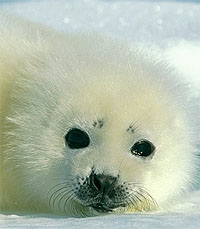 Help Us Grow!
Help Us Grow! Saving Wildlife Together - Saving the Harp Seal
Saving Wildlife Together - Saving the Harp SealHarp Seal
(go back to The Animals)
 About 150 years ago, there were about 10 million harp seals found in northern Atlantic waters. Their numbers had decreased by more than two-thirds by the 1960s. Blamed for depleting fish stocks, harp seals were hunted by fishermen. Fur hunters clubbed and skinned pups to make fashion items. This brutal treatment of the pups has led to protective measures. Hunting quota allows only a certain number of seals to be killed which has increased the harp seal population by about five percent yearly. Populations of harp seals migrate south to their breeding grounds in the spring. Juveniles and pregnant cows (females) reach the breeding grounds in early February. Born at winterís end with a warm coat, the single pup feeds on its motherís milk for only two weeks. The pup is quickly weaned because the mother cannot feed while the pup is suckling and because the pup, who remains on the ice while suckling, is in danger from bears. Once the pup is weaned, it molts its baby fur and learns how to catch its own food, consisting of a diet of shrimp. Adult harp seals eat capelin, cod, and herring as well as shrimp.
About 150 years ago, there were about 10 million harp seals found in northern Atlantic waters. Their numbers had decreased by more than two-thirds by the 1960s. Blamed for depleting fish stocks, harp seals were hunted by fishermen. Fur hunters clubbed and skinned pups to make fashion items. This brutal treatment of the pups has led to protective measures. Hunting quota allows only a certain number of seals to be killed which has increased the harp seal population by about five percent yearly. Populations of harp seals migrate south to their breeding grounds in the spring. Juveniles and pregnant cows (females) reach the breeding grounds in early February. Born at winterís end with a warm coat, the single pup feeds on its motherís milk for only two weeks. The pup is quickly weaned because the mother cannot feed while the pup is suckling and because the pup, who remains on the ice while suckling, is in danger from bears. Once the pup is weaned, it molts its baby fur and learns how to catch its own food, consisting of a diet of shrimp. Adult harp seals eat capelin, cod, and herring as well as shrimp.
Harp Seal - Fast Facts
Type: MammalDiet: Carnivore
Average Life in Wild: 30 years
Size: 5.25 to 6.25 ft.
Weight: 400 lbs
Did you know? Young harp seals are born on the ice and mothers identify their own offspring from the many others by their smell.
Status: STABLE
Buy an Eye and help save the Harp Seal.


 Help
Help





 Check this out...
Check this out...
 Your Account
Your Account